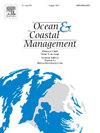印度沿海灾害的脆弱性和风险评估:来自文献计量分析和系统回顾的见解
IF 4.8
2区 环境科学与生态学
Q1 OCEANOGRAPHY
引用次数: 0
摘要
沿海系统经常面临飓风、海啸、洪水、风暴潮、海平面上升和侵蚀等多种灾害,已被确定为气候诱发风险的前沿。尽管了解风险和脆弱性水平的评估过程只指导了有限的行动,但这些仍然是确定“特别”脆弱的目标领域的“客观”手段的宝贵工具。有必要全面了解这些评估是如何概念化和操作的,以了解阻碍将结果有效转化为可操作决策的挑战。该研究结合了文献计量分析和系统回顾两种互补的方法,综合了沿海系统对自然灾害过程的风险和脆弱性评估的文献。文献计量分析是一种成熟的研究方法,用于分析出版趋势、作者和期刊信息、热点主题及其共现性。进行了系统的文献审查,以收集关于研究区域、研究的危害类型、报告的规模、使用的方法和工具、使用的指标、确定的差距、政策分析和报告的风险评估产出的可用性的具体见解。我们回顾了2000年至2024年间发表的178项研究。结果表明:(1)近5年脆弱性与风险评估领域的研究与前10年相比增长了近2倍;(2)大部分研究集中在东部沿海的西孟加拉邦、泰米尔纳德邦、奥里萨邦和安得拉邦;(3)半数被审查的研究侧重于多重灾害引起的风险或脆弱性,其次是气旋(15.7%);(4)指标评价是最常用的评价方法(63%);(5)生物地球物理指标比社会经济指标更常被调查;(6)行政层面的报告主要集中在村庄(37.9%)。在定性评估的基础上对以往的研究进行定量分析后,该研究报告了风险(和脆弱性)的定义和概念框架的显著模糊。此外,大多数研究含蓄地强调协助政策制定,但往往未能明确处理政策过程的具体类型或阶段。总之,本研究对印度沿海地区自然灾害风险和脆弱性评估的现有知识进行了全面概述。本文章由计算机程序翻译,如有差异,请以英文原文为准。
Vulnerability and risk assessment of coastal hazards in India: Insights from bibliometric analysis and systematic review
Coastal systems, often exposed to multiple hazards like cyclones, tsunamis, floods, storm surges, sea level rise and erosion, have been identified to be at the forefront of climate-induced risks. Although assessment processes of comprehending the risk and vulnerability level have guided only limited action, these remain valuable tools for an ‘objective’ means to identify targeted areas focusing on ‘particularly’ vulnerable. A holistic understanding of how these assessments are conceptualised and operationalised is necessary to understand the challenges that hinder effective translation of the results into actionable decisions. The study combines two complementary methods—bibliometric analysis and systematic review—to synthesise the literature on risk and vulnerability assessment in coastal systems to natural hazard processes. Bibliometric analysis, an established research methodology, was used to analyse trends in publication, author and journal information, hotspot themes and their co-occurrence. A systematic literature review was done to gather specific insights on the regions of study, type of hazards studied, scale of reporting, methods and tools used, indicators used, gaps identified, policy analysis and the reported usability of the risk assessment outputs. We reviewed 178 studies published between 2000 and 2024. The results report (1) nearly twofold growth in studies in the domain of vulnerability and risk assessment in the last 5 years as compared to the previous decade; (2) majority of research focused on the eastern coastal states of West Bengal, Tamil Nadu, Odisha, and Andhra Pradesh; (3) half of the reviewed studies focused on risk or vulnerability arising due to multiple hazards, followed by cyclones (15.7 %); (4) indicator-based assessments were the most commonly used method (63 %); (5) biogeophysical indicators were more commonly investigated than socioeconomic and (6) the administrative level of reporting majorly focussed on villages (37.9 %). After quantitatively analysing previous research based on qualitative assessment, the study reports significant vagueness in definitions of risk (and vulnerability) and conceptual frameworks. Further, the majority of the studies implicitly emphasised assisting in policy formulation but often failed to explicitly address the specific type or stage of the policy process. In conclusion, this study provides a comprehensive overview of the current knowledge on risk and vulnerability assessment for natural hazards in the coastal regions of India.
求助全文
通过发布文献求助,成功后即可免费获取论文全文。
去求助
来源期刊

Ocean & Coastal Management
环境科学-海洋学
CiteScore
8.50
自引率
15.20%
发文量
321
审稿时长
60 days
期刊介绍:
Ocean & Coastal Management is the leading international journal dedicated to the study of all aspects of ocean and coastal management from the global to local levels.
We publish rigorously peer-reviewed manuscripts from all disciplines, and inter-/trans-disciplinary and co-designed research, but all submissions must make clear the relevance to management and/or governance issues relevant to the sustainable development and conservation of oceans and coasts.
Comparative studies (from sub-national to trans-national cases, and other management / policy arenas) are encouraged, as are studies that critically assess current management practices and governance approaches. Submissions involving robust analysis, development of theory, and improvement of management practice are especially welcome.
 求助内容:
求助内容: 应助结果提醒方式:
应助结果提醒方式:


